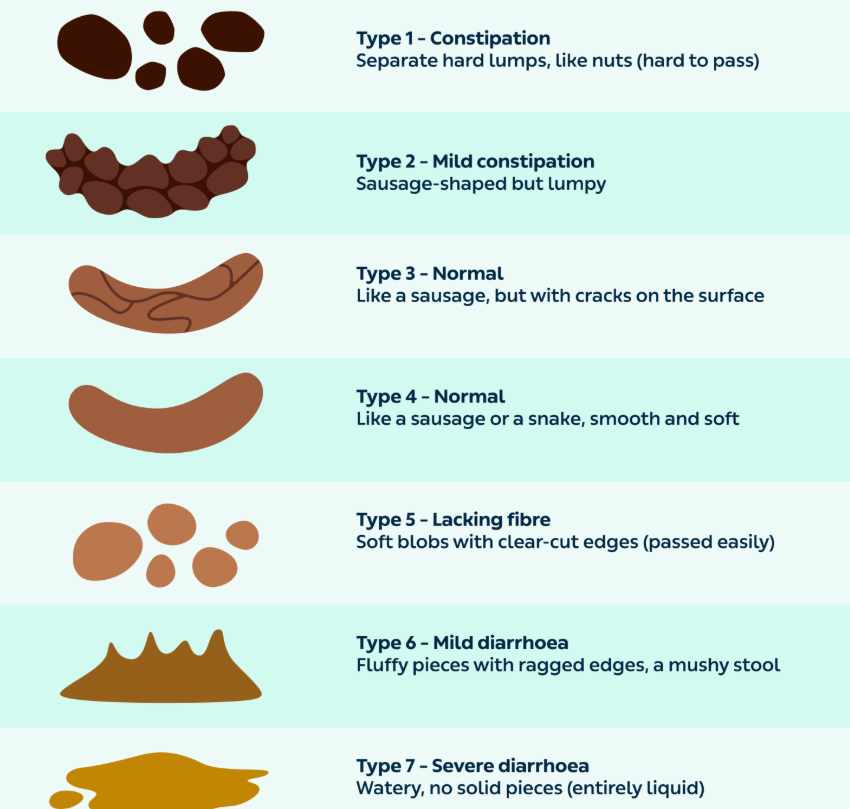Defecation is a crucial channel for our bodies to excrete toxins. We can learn about our health through bowel movements, and clinicians often refer to stool characteristics and laboratory tests to ultimately determine the underlying condition.
Defecation is a crucial channel for our bodies to excrete toxins. We can learn about our health through bowel movements, and clinicians often refer to stool characteristics and laboratory tests to ultimately determine the underlying condition.
What does normal stool look like?
Normal stool is banana-shaped, soft, and of a moderate color. Defecation is not accompanied by any discomfort, such as abdominal pain or a feeling of urgency. A normal adult defecates once a day, weighing approximately 100-300 grams. Of course, this is just a statistical estimate, and everyone's situation varies, but the variance is not significant. The key consideration is whether there is discomfort or changes in stool after defecation.

Stool Color
- Black Stool:
The Mayo Clinic states that black stool is not caused by pathology but may be related to diet, such as iron-rich foods like animal blood, beef, liver, and black jam. Alternatively, you may be taking medications such as iron supplements or black licorice. A variety of factors can cause black stool. If you stop taking these foods or medications but still have black stool, consider a pathological cause, possibly gastrointestinal bleeding, possibly in the stomach.
- Green Stool:
Green stool indicates that food enters the intestines too quickly, preventing bile from breaking it down.
A common cause is consuming too much green pigment, such as leafy vegetables.
- Light-colored or white stool:
If your stool turns white, it means there's insufficient bile in the stool, indicating a blockage in the bile duct. This blockage may be caused by medications, such as antidiarrheals or other drugs.
- Yellow or greasy stool:
Yellow, greasy, or foul-smelling stool indicates an unhealthy diet or excessive fat intake. It can also be due to intestinal damage or malabsorption, such as lactose intolerance. Lactose intolerance occurs when the body lacks the enzyme glycogenolysis and cannot fully break down lactose, leading to poor absorption and indigestion.
- Red stool:
Red stool is relatively easy to identify, such as bloody stool caused by hemorrhoids or anal rupture. However, to be safe, it's best to visit a doctor for a checkup and appropriate treatment.
What are the different types of changes in stool color and consistency? What do they represent?
- Watery or porridge-like stools
This is primarily seen in various infectious or non-infectious diarrheal conditions, such as acute gastroenteritis and hyperthyroidism.
- Rice-water-like stools
This is a typical manifestation of cholera.
- Mucus, pus, and blood in stool or simply blood and pus in stool
Can be seen in dysentery, ulcerative colitis, and rectal cancer.
- Jelly-like stools
Can be seen in irritable bowel syndrome and chronic bacillary dysentery. In cases of amoebic dysentery, the stool is primarily bloody and dark red, resembling jam, also known as jam-like stool. In contrast, bacillary dysentery is primarily characterized by mucus, pus, and blood in stool or simply blood and pus in stool. 5. Bloody stools
Most often result from bleeding in the lower intestine, such as hemorrhoids, anal fissures, and rectal cancer.
- Tarry stools
This usually indicates upper gastrointestinal bleeding. The blood reacts chemically with stomach acid, resulting in a tarry appearance when it reaches the body.
- Off-white stools
This occurs in obstructive biliary tract infections. Conjugated bilirubin produced in the liver cannot pass through the blocked bile duct into the intestine, resulting in a white stool color.
- Thin, stringy stools: Commonly seen in rectal cancer.
- Green stools: Indicates indigestion.
- Sheep-fecal stools: Commonly seen in the elderly and postpartum women with difficulty defecating.

Different stool odors have different meanings.
- Foul odor: Chronic enteritis, pancreatic disease, and ulcers of colon and rectal cancer can produce this odor.
- Fishy odor: Common in amoebic dysentery.
- Sour odor: Common in digestive problems with fats and carbohydrates or indigestion. How can you address irregular bowel movements? The Health and Wellness University explains six methods.
- Drinking more vegetable juice can detoxify and eliminate intestinal stool (intestinal stool is stool that has remained in the intestines for more than 48 hours).
- Consume more dietary fiber, such as sweet potatoes, corn, and kelp.
- Eat more dark green vegetables and probiotics.
- Develop good bowel habits: Those who suffer from frequent constipation should make sure to schedule their bowel movements at reasonable times and go to the toilet at regular times to develop good bowel habits.
- Increase exercise: Participating in physical activities and physical labor can enhance gastrointestinal motility, increase appetite, and strengthen the diaphragm, abdominal muscles, and anal muscles, thereby improving bowel movement and preventing constipation.
- Medication: Oral probiotics (such as Bifidobacterium) can be used.
